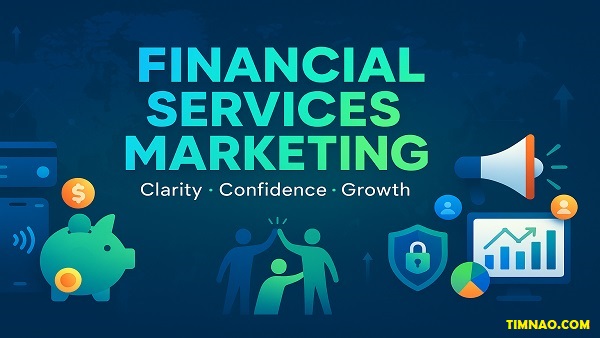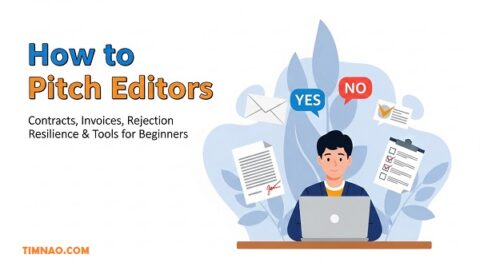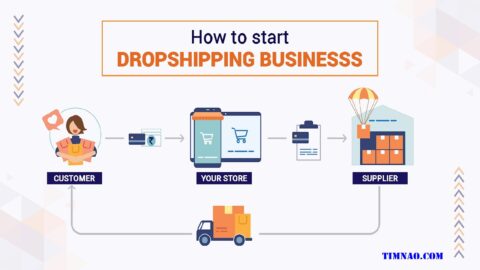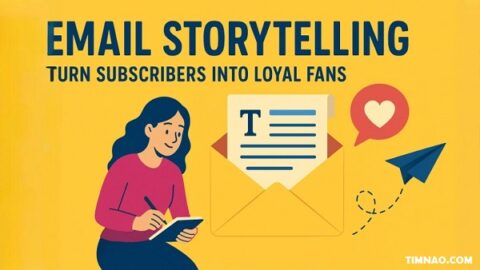Financial Services Marketing That Wins: The Beginner’s Ultimate Playbook 🚀
Financial services marketing can look intimidating from the outside: strict rules, complex products, intense competition, and customers who are understandably cautious with money. Yet for beginners, this field is full of opportunity. When you understand what people really hire banks and insurers to do—protect, smooth, and grow their money—you can design experiences that earn trust and deliver growth. This guide translates industry principles into clear, practical moves you can use right away.
Table of Contents
- 📈 Why This Market Is Different—and Full of Opportunity
- 🧩 Money “Jobs”: What Customers Actually Need From You
- 🛡️ Trust First: Ethics, Consent & Compliance as Growth Levers
- 🎯 Stand Out: Positioning & Brand Strategy for Financial Services
- 🔧 The Beginner’s 2P2C Marketing Mix for Banks & Insurers
- 📣 Acquisition That Respects the Rules (and Still Scales)
- 📱 Digital Experiences That Reduce Churn & Boost Activation
- 📊 Data, Analytics & First‑Party Growth for FS Marketers
- 📚 Content & Community that Build Financial Confidence
- 🌱 Inclusion & ESG: Make Doing Good Your Daily Advantage
- 🗺️ A 90‑Day Starter Roadmap (with quick wins)
- 🧪 Mini Case Examples for Inspiration
- ❓ Short FAQ for Beginners
- ✅ Key Lessons & Takeaways
📈 Why This Market Is Different—and Full of Opportunity
When you begin exploring financial services marketing, one thing becomes obvious: this is not like selling shoes, gadgets, or even SaaS tools. Money is deeply personal. It touches nearly every area of a customer’s life—family, work, health, security, and dreams. That means people approach banks, insurance firms, and fintechs with more caution, more questions, and higher expectations.
For beginners, this might feel intimidating, but here’s the exciting part: because trust is central, marketers who can communicate clearly and empathetically have a huge advantage. If you can show customers you understand their concerns, explain complex products in plain language, and remove friction from their journey, you can stand out in a crowded market.
Financial Services Are Intangible
Most products can be touched, tried, or compared side by side. But with financial services, you’re essentially marketing a promise:
- A bank promises to keep money safe.
- An insurer promises to protect against future risks.
- An investment platform promises growth opportunities.
These promises only become real over time, often years. Because customers cannot “test-drive” a pension plan or savings account, they look for signals of reliability: clear communication, easy access to support, positive reviews, or strong brand reputation.
For you as a marketer, this means your role is to make the invisible visible. Instead of focusing only on features, you need to show outcomes: peace of mind, faster payments, or a smoother path to a home loan.
The Emotional Weight of Money
Unlike fashion or electronics, financial decisions carry emotional weight. Signing up for a mortgage, investing in retirement, or even choosing a new current account can spark anxiety. People often fear making the wrong choice or missing hidden costs.
As a marketer, your campaigns must not only inform but also reassure. Use case studies, customer stories, and transparent pricing examples. For instance, showing “Borrow $1,000, repay $1,050 over 12 months” is far clearer than “APR 9.9%.” Beginners who adopt this clarity-first mindset can build trust quickly.
Regulations as a Trust Advantage
Many beginners worry about strict regulations. It’s true—you can’t overpromise, run misleading ads, or hide disclaimers in small print. But far from being a burden, regulation is actually a competitive advantage.
When you design marketing that complies with rules, you show customers you’re safe and responsible. In fact, transparency is one of the strongest differentiators in financial services. A simple side-by-side comparison chart of fees, or a plain-English explanation of coverage exclusions, can convert hesitant customers into loyal ones.
Think of regulation as your “trust framework.” By staying compliant, you not only protect your business but also strengthen your brand.
A Market in Constant Change
Financial services are evolving at high speed:
- Digital wallets like Apple Pay, Google Pay, and PayPal already handle nearly half of global e-commerce payments. Customers now expect tap-and-go convenience everywhere.
- Open banking has opened the door for new providers to offer account aggregation, instant payments, and tailored budgeting tools.
- Fintech challengers continue to grow by delivering mobile-first, user-friendly experiences—forcing traditional banks to raise their game.
For marketers, this means opportunities are everywhere. Even small players can attract attention if they address specific customer needs with clarity and speed.
Why Beginners Should Feel Encouraged
Big institutions often move slowly because of their size and internal processes. As a beginner, you bring agility and fresh perspective. You can speak like a real human being, experiment with creative content, and focus on customer needs rather than legacy systems.
Customers reward brands that speak their language, simplify financial jargon, and deliver quick wins. Whether you’re working for a large bank or a small fintech, your ability to empathize and communicate clearly is your superpower.
🧩 Money “Jobs”: What Customers Actually Need From You
Before designing campaigns, forget products for a moment. Instead, think in terms of jobs to be done—the real tasks customers are trying to solve with money. This mindset shift is critical for beginners because it helps you see beyond features and into the everyday struggles people face.
The Five Core “Money Jobs”
Here are the universal jobs customers hire financial services to do:
- Move Money Efficiently
- Get paid, pay bills, send money abroad, or split expenses with friends.
- Customers want this fast, cheap, and error-free.
- Example: A mobile app that shows real-time transfers with instant alerts reduces stress.
- Smooth Out Income and Expenses
- People need help bridging timing gaps—like covering bills before payday.
- Overdrafts or short-term credit can be costly; smart marketers frame alternatives as supportive, not punitive.
- Example: A “salary advance” feature marketed as “no more waiting until payday.”
- Protect Against Risks
- Life throws curveballs: illness, accidents, fraud, job loss.
- Insurance, identity protection, and fraud monitoring give customers peace of mind.
- Example: Marketing car insurance as “get back on the road in 24 hours, no hassle.”
- Grow Wealth
- Saving, investing, and pensions help people prepare for future goals.
- Beginners should focus on simplicity—don’t lead with jargon like “index-linked annuities.” Instead, explain outcomes.
- Example: “Turn $5 a day into $10,000 in five years with automatic savings.”
- Stay in Control and Feel Confident
- Ultimately, money management is about reducing anxiety.
- Tools like dashboards, budgeting nudges, and spending alerts help customers feel informed and in charge.
- Example: A push notification: “You’re on track to hit your holiday savings goal.”
How to Use Money Jobs in Marketing
Once you understand these jobs, you can tailor your message and design more relevant offers:
- Website copy should highlight the job, not the product. Instead of “We offer current accounts,” say “Pay bills, save automatically, and see your money in one place.”
- Campaigns should focus on outcomes. For example, advertise a savings account as “Emergency fund, sorted in six months,” not “1.2% interest rate.”
- Onboarding should deliver a quick win. A budgeting app might highlight “Your first savings milestone reached” within days of signup.
This approach helps beginners avoid the trap of overwhelming customers with technical details. Instead, you meet them where they are—focused on solving daily problems.
Why This Matters for Beginners
When you design around money jobs:
- Customers immediately see relevance—they think, “This brand gets me.”
- Marketing messages become simpler, making it easier to create content without deep technical knowledge.
- You can differentiate even in competitive markets by focusing on outcomes instead of complex features.
In other words, jobs-to-be-done gives you a roadmap for customer-centric marketing that builds trust and drives growth.
Practical Steps You Can Try Right Now
- Interview three customers or friends. Ask them: “What’s the hardest part about managing money right now?”
- Write down their answers, then group them into one of the five jobs.
- Rewrite one of your product descriptions so it clearly explains how it solves that job.
- Test that message in your next campaign, social post, or landing page.
This small experiment will immediately make your marketing feel more relevant and human.
🛡️ Trust First: Ethics, Consent & Compliance as Growth Levers
If there’s one golden rule in financial services marketing, it’s this: trust is the product. Customers don’t just buy an account, a card, or an insurance policy—they’re buying peace of mind that their money will be safe, their data will be respected, and their provider won’t take advantage of them.
For beginners, this may sound abstract, but it translates into very practical actions. When you put ethics, consent, and compliance at the heart of your strategy, you don’t just avoid regulatory headaches—you actually create growth levers. Customers reward transparency and responsibility with loyalty and referrals.
Why Trust Is a Business Multiplier
- Low trust = high cost. Customers who don’t trust you shop around, abandon forms, or require expensive acquisition incentives.
- High trust = low friction. Customers who trust you complete applications faster, stick around longer, and buy more over time.
In finance, every click, form, and message is a chance to either build or erode trust. That’s why marketers need to design trust into the journey, not just into legal disclaimers.
Clear Pricing and Plain Language
For many customers, financial products feel like a maze of hidden fees and jargon. Your job is to turn that maze into a well-lit path.
- Replace “APR 19.9% variable” with “Borrow $1,000, repay $1,199 over 12 months.”
- Show real scenarios: “If you miss a payment, here’s what happens.”
- Use bullet points for key fees—don’t bury them in long paragraphs.
A beginner-friendly tip: after writing copy, ask a friend outside finance to read it. If they can’t explain it back in one sentence, simplify further.
Building for Vulnerable Customers
Not all customers are equally confident with money. Some face challenges due to health, job loss, or lack of financial literacy. Designing with them in mind improves trust for everyone.
- Offer multiple support channels: phone, chat, branch/video.
- Add “positive friction” in risky moments, like a second confirmation before a large transfer.
- Use plain-English “What’s not covered” cards in insurance products.
By doing this, you send a message: we’re here to protect, not exploit.
Consent and Data Privacy
Data is the engine of modern marketing, but in finance, it must be used carefully. Customers want personalization, but only when they feel in control.
- Implement clear consent flows: “Yes, I want tailored offers” / “No, keep it generic.”
- Respect privacy laws like GDPR in Europe or CCPA/CPRA in California.
- Be transparent: explain what each data point is used for and why it benefits the customer.
Instead of hiding behind a 30-page privacy policy, create a one-page summary with icons and plain language. Beginners can win quick trust with this simple step.
Security That Reassures
Most people don’t understand encryption standards or compliance codes like PCI DSS. But they do understand promises like:
- “24/7 fraud monitoring.”
- “Zero-liability on unauthorized transactions.”
- “Instant card lock in the app.”
Make these protections visible in your marketing. When customers see you actively protecting them, they’re more likely to engage.
Responsible Use of AI and Automation
AI is transforming financial services—from chatbots to credit scoring—but it must be used responsibly. Customers fear “black box” decisions.
- Be transparent: “AI helps us detect fraud faster, but humans review every case.”
- Publish a short AI statement explaining how it supports—not replaces—human judgment.
- Provide appeal channels for automated decisions.
This honesty can turn a potential trust risk into a trust advantage.
🎯 Stand Out: Positioning & Brand Strategy for Financial Services
Once you’ve built trust, the next step is to differentiate. Financial products often look similar: savings accounts, credit cards, loans. The real question is: why should customers choose you?
For beginners, this comes down to positioning—deciding what you stand for and making it clear in every touchpoint.
Choosing Your Positioning Lane
Here are four common (and effective) lanes:
- Price Leader
- Transparent fees, competitive rates.
- Example: a digital bank that offers free international transfers.
- Service Leader
- Exceptional support and fast issue resolution.
- Example: a credit union with 24/7 human chat.
- Values Leader
- Focus on inclusion, sustainability, or ethical investing.
- Example: an insurer that plants trees for every policy sold.
- Specialist
- Tailored solutions for a specific group (students, freelancers, expats).
- Example: a lender offering products built for gig workers.
Making Positioning Tangible
Customers don’t just believe words—they look for proof. Bring your positioning to life with signals they can see:
- If you’re a price leader, show side-by-side comparisons.
- If you’re a service leader, publish average response times.
- If you’re a values leader, track and share measurable impact.
Even small signals (like “average wait time: 42 seconds”) can make a big difference.
Speaking to Emotions, Not Just Logic
Money decisions are rarely purely rational. Positioning should connect emotionally as well as logically.
- Target fear: “Protect your family, whatever happens.”
- Target hope: “Save for the future you deserve.”
- Target pride: “Join millions of smart savers building wealth.”
Mix emotions with clarity, and your brand voice will feel human and relatable.
Avoiding the “Me-Too” Trap
Many financial institutions end up sounding identical. To avoid blending in:
- Name the enemy: highlight what you stand against (hidden fees, confusing terms).
- Tell stories: show how you solved real customer problems.
- Be consistent: repeat your positioning across website, ads, and onboarding.
A beginner mistake is changing tone every campaign. Remember: consistency builds credibility.
Practical Steps for Beginners
- Write down three things your brand does better, faster, or fairer than competitors.
- Turn each into a customer-facing promise (e.g., “We answer calls in under 1 minute”).
- Test these promises in small campaigns and see what resonates most.
- Double down on the strongest one—that’s your positioning lane.
🔧 The Beginner’s 2P2C Marketing Mix for Banks & Insurers
Marketing in financial services can feel overwhelming at first—there are countless products, strict rules, and customers with very different needs. To keep things simple, beginners can use a practical framework called 2P2C: Product, Price, Process, Communication—all wrapped with Convenience. Think of it as a compass to design campaigns and offers that actually solve customer problems.
Product: Bundle Around “Money Jobs”
Financial products are often sold as accounts, loans, or policies—but customers don’t wake up thinking, “I need a current account.” They think, “I need to pay my bills easily” or “I need to protect my family.”
For beginners, the best way to design product messaging is to bundle features around real-life jobs.
- Everyday banking: Pair a free account with instant mobile alerts and spending insights.
- Short-term credit: Offer small, transparent credit lines with built-in budgeting reminders.
- Insurance: Provide plain-English coverage summaries alongside quotes, highlighting “what’s not covered.”
- Savings and wealth: Add smart tools like “round-ups” or “goal trackers” to show progress quickly.
👉 Tip: When writing copy, talk about outcomes: “Your emergency fund, ready in 6 months” instead of “1.5% annual interest.”
Price: Fair, Flexible, Transparent
Price is a sensitive point in finance. Customers are tired of hidden fees and confusing terms. Beginners can win trust by making price visible and easy to calculate.
- Create a single pricing page with simple examples.
- Show total repayment costs for loans, not just APRs.
- Offer tiered value packs (e.g., free essentials + premium extras).
- Reward positive behavior: lower fees for on-time repayments or better savings rates for consistent deposits.
👉 Example: Instead of advertising “Credit card APR 18.9%,” try “Borrow $500, repay $515 over 3 months. No hidden fees.”
Process: Remove Friction, Add Confidence
Processes often make or break customer trust. Long, confusing forms are the fastest way to lose leads. Beginners should focus on clear steps and visible progress.
- Eligibility checks without hard credit pulls reduce application anxiety.
- Progress bars show customers how close they are to finishing forms.
- Real-time updates (“Your card is on the way”) prevent uncertainty.
- Progressive profiling: collect only essential info upfront, ask for extras later.
👉 Quick win: Rewrite application forms to use one-column mobile layouts. Customers finish faster, and completion rates rise.
Communication: Be Useful, Not Loud
Financial marketing often relies on generic emails or push notifications that annoy customers. Beginners can do better by shifting from broadcasts to useful nudges.
- Replace “Welcome to our bank” with “Set your first savings goal today—it takes 1 minute.”
- Use event triggers: salary arrives, unusual spend detected, policy near renewal.
- Create a self-help hub with calculators, FAQs, and short guides.
- Use human language, not corporate jargon.
👉 Test this yourself: Show your campaign to a friend. If they say, “This sounds like a bank ad,” rewrite it until it sounds like friendly advice.
Convenience: The Glue That Holds It All Together
Customers care less about channels than about convenience. They want to move seamlessly between app, website, call center, or branch.
- Ensure mobile-first experiences with one-tap features.
- Support digital wallets like Apple Pay and Google Pay.
- Offer chatbots + humans so customers choose how they interact.
- For areas with limited access, partner with retailers for fee-free cash withdrawals.
Convenience isn’t about doing everything; it’s about doing the basics beautifully.
📣 Acquisition That Respects the Rules (and Still Scales)
Once you’ve built a clear offering, the next challenge is getting customers—while staying compliant. For beginners, this means finding ways to grow that are creative, ethical, and sustainable.
Organic Search (SEO) for Beginners
In finance, Google treats content as “Your Money or Your Life” (YMYL). That means it requires expertise, experience, authority, and trust (E-E-A-T).
- Write evergreen guides (e.g., “How to build an emergency fund”) that answer real questions.
- Keep authors visible—show real experts with bios and credentials.
- Update pages regularly. Outdated financial advice hurts both SEO and trust.
- Use plugins like RankMath to optimize keywords, meta descriptions, and schema.
👉 Beginner tip: Start with 5 core blog posts tied to common customer “money jobs.” These become your SEO foundation.
Paid Ads That Play Fair
Ads can scale acquisition quickly—but in finance, targeting and wording must respect regulations.
- Use Google Ads with compliant copy. Avoid overpromises like “Guaranteed approval.”
- Build first-party audiences (people who visited your site with consent).
- For B2B (e.g., SME lending), try LinkedIn Ads; for consumer deposits, explore Meta or TikTok Ads.
- Always test disclaimers and clarity: customers must see both benefits and risks.
👉 Example: Instead of “Best student loan ever,” try “Low-fee student loan—check eligibility in 2 minutes, no credit score impact.”
Partnerships That Compound
Scaling doesn’t always mean more ads. Partnerships can deliver trust and volume quickly.
- Employers: Offer salary-advance or savings tools through HR.
- Universities: Co-create starter packs for students.
- Trade groups: Provide tailored financial solutions for specific industries.
- Fintech APIs: Integrate with tools like Plaid or Stripe for seamless onboarding.
Beginners should focus on one strong partnership first, rather than spreading too thin.
On-Site Conversion: Don’t Lose the Click
Getting a lead to your site is only half the battle. Converting them requires clarity and reassurance.
- Add eligibility checkers with instant results.
- Use live chat or chatbots to reduce form abandonment.
- Display social proof like Trustpilot reviews.
- Keep forms short—ask for essentials only.
👉 Try this: Run a small A/B test on your application page. Compare “long form upfront” vs. “short form + follow-up.” You’ll likely see a big boost in completion rates.
Respectful Retargeting
Many beginners overdo retargeting with endless ads. In finance, this backfires. Instead, use retargeting to add value.
- Show reminders like: “Still comparing? Here’s a side-by-side fee breakdown.”
- Offer useful guides, not just product ads.
- Limit frequency—no one wants to see the same ad 20 times.
By staying respectful, you maintain trust while nudging customers forward.
📱 Digital Experiences That Reduce Churn & Boost Activation
Acquiring new customers is only half the battle. In financial services, activation and retention often matter more than the initial sign-up. A customer who opens an account but never funds it, or who cancels an insurance policy after the free trial, is wasted effort. For beginners, the key is simple: design digital experiences that create value fast and keep customers engaged.
Why Activation Matters
Activation is the moment when a customer experiences their first “aha” with your product. In banking, it might be the first salary deposit. In insurance, it might be uploading key documents or completing a coverage check. Without this first win, churn skyrockets.
👉 Think of activation as the customer saying: “This works for me, I trust it, I’ll stick with it.”
Designing Clean Onboarding
Your onboarding experience sets the tone for the entire relationship. Beginners should focus on clarity, speed, and reassurance.
- Clear paths: Let customers choose—personal vs. business, savings vs. loans—without confusion.
- Smooth verification: Use quick, secure ID verification (document scan + selfie). Provide guidance if something fails.
- Instant funding: Encourage salary deposits or first transfers with one-tap open-banking connections.
- First protections: Set up alerts, card controls, and two-factor authentication early.
- Celebrate first success: Congratulate customers when they hit milestones (first deposit, first saved $100, first claim filed).
Nudges That Drive Engagement
Don’t assume customers will explore features on their own. Smart nudges can gently guide them:
- Positive reinforcement: Celebrate savings milestones or on-time repayments.
- Next best action: Suggest setting a budget after detecting first spending.
- Proactive protection: Alert users if they’re at risk of overdraft, offering solutions like micro-savings or buffer credit.
👉 Beginners should avoid “spammy” nudges. Each message should clearly answer: “How does this help the customer right now?”
Recovery When Things Go Wrong
Mistakes happen—delays, system outages, or fraud scares. How you respond defines customer loyalty.
- Fast acknowledgment: Don’t hide issues—send immediate updates.
- Plain explanations: Avoid technical jargon; focus on what’s being done.
- Make it right: Offer compensation or gestures (e.g., fee waivers).
A structured “make it right” playbook reassures customers that problems won’t be ignored.
Accessibility by Design
Inclusive digital experiences expand your reach and build trust.
- Provide screen-reader compatibility.
- Offer high-contrast and text-resize options.
- Use simple language, avoiding legalese.
- Add multilingual support for key flows.
Beginners often overlook accessibility, but it’s a powerful differentiator that signals fairness.
📊 Data, Analytics & First-Party Growth for FS Marketers
In today’s financial world, data is currency. But with cookies fading and regulations tightening, marketers must learn to grow using first-party data—information customers share directly and consensually. Done right, this builds stronger personalization and long-term trust.
Why First-Party Data Wins
- Durable: Unlike third-party cookies, it can’t be “switched off” by browsers.
- Compliant: Customers consent to share it, making it safer legally.
- Actionable: It connects directly to business outcomes like loan approvals or policy renewals.
👉 Beginners should see data as a way to serve customers better, not just to sell more.
Key Metrics to Track
Focusing on the right metrics helps you avoid drowning in dashboards. Start with these essentials:
- Acquisition: Cost per qualified application (CPQA), approval rate, funded rate.
- Activation: Time to first deposit, first card tap, or first claim.
- Engagement: Savings frequency, policy add-ons, card-on-file adoption.
- Trust signals: Complaint rates, fraud resolution times.
- Value: Risk-adjusted customer lifetime value (CLV).
👉 Beginners should track fewer, clearer metrics first. It’s better to master five KPIs than juggle fifty.
Building Your Beginner Data Stack
You don’t need an enterprise system to get started. A simple, beginner-friendly stack can look like this:
- CRM: HubSpot or Salesforce to manage relationships.
- Analytics: Google Analytics 4 for behavior tracking, Looker Studio for dashboards.
- Customer data platforms (CDPs): Segment or Braze to unify data and run campaigns.
- Experimentation tools: Optimizely or VWO for A/B tests.
The secret is integration. Even a small stack is powerful if tools talk to each other.
Attribution Without Creepiness
Beginners often struggle with attribution—figuring out which campaign drove results. While old cookie tracking is fading, you can still:
- Import offline conversions (loan approvals, policy sales) back into ad platforms.
- Use modeled conversions in Google Ads and Meta Ads to respect consent choices.
- Run geo-based tests (compare regions with vs. without a campaign).
- Explore marketing mix modeling (MMM) for broader insights.
👉 The key is honesty. Don’t overpromise precision; share insights with humility.
Data Storytelling for Beginners
Numbers mean little unless they tell a story. Beginners should practice explaining insights in plain language:
- Instead of “Activation is at 35%,” say “Only 1 in 3 new customers actually use their account in the first week—we’re losing two-thirds.”
- Instead of “Churn is down 10%,” say “Last month, 500 more people stayed with us compared to before.”
This storytelling approach makes data actionable and keeps teams aligned.
Growing Responsibly with First-Party Data
The final piece is using data in a way that strengthens—not erodes—trust.
- Be transparent about what data is collected and why.
- Give customers control: preferences, opt-outs, and data deletion options.
- Use data to add value: alerts, personalized tips, or reminders—not just sales pitches.
👉 Remember: every time you respect data boundaries, you reinforce loyalty.
📚 Content & Community that Build Financial Confidence
Financial services are often intimidating for beginners. Complex jargon, overwhelming product options, and the fear of making the “wrong” decision keep many people from engaging fully with their money. This is where content and community marketing become powerful tools. Instead of selling, you teach. Instead of broadcasting, you engage. Done well, content builds customer confidence, while community creates a sense of belonging. Both together strengthen long-term loyalty.
Why Content Is Essential in Finance
Unlike many industries, financial services are trust-driven. Customers rarely make instant decisions; they research, compare, and seek reassurance. Content fills that gap by:
- Educating customers: Explaining terms and processes in simple ways.
- Reducing fear: Turning “I don’t understand” into “I can do this.”
- Driving discovery: SEO-friendly guides attract customers early in their decision process.
- Supporting retention: Helpful content keeps existing customers engaged beyond the first purchase.
👉 Beginners should see content not as “extra,” but as a core acquisition and retention channel.
Types of Beginner-Friendly Content
- Micro-guides
- Bite-sized articles like “3 steps to start saving $50 a month.”
- Use plain language and bullet points.
- Interactive tools
- Mortgage calculators, savings goal trackers, insurance coverage checklists.
- Let customers “play” with numbers to visualize impact.
- Short videos
- TikTok or YouTube explainers: “What is APR?” or “How does travel insurance actually work?”
- Visual storytelling makes concepts stick.
- Email mini-courses
- Send 5-day series like “Beginner’s guide to budgeting.”
- Builds trust through consistent value.
Building Community Around Money
Content works well alone, but community turns education into conversation. People want to share experiences, ask questions, and feel they’re not alone.
- Private groups: Create safe spaces on Facebook, LinkedIn, or within your app.
- Live webinars & Q&As: Host sessions with experts on topics like “First-time home buying.”
- User stories: Feature real customers’ journeys, from debt payoff to starting a business.
- Challenges: Run gamified campaigns like “Save $100 in 30 days together.”
👉 Pro tip: For beginners, even a small, engaged community beats a large but inactive one.
Turning Content Into Conversion
Content is only powerful if it connects to next steps.
- End every article with a clear action: “Open a starter savings account in 2 minutes.”
- Use CTAs that feel like help, not pressure: “Check how much you could save—no sign-up required.”
- Map content to money jobs: a guide on budgeting should link naturally to your savings product.
🌱 Inclusion & ESG: Make Doing Good Your Daily Advantage
In finance, being inclusive and responsible isn’t just a trend—it’s a business imperative. Customers increasingly choose brands that reflect their values. For beginners, embracing inclusion and ESG (Environmental, Social, and Governance) practices can be a shortcut to differentiation and long-term trust.
Why Inclusion Matters
Millions of people are underserved by traditional finance: gig workers, immigrants, low-income households, or those with limited digital literacy. By designing with them in mind, you:
- Expand your market.
- Win loyalty from overlooked groups.
- Signal fairness and responsibility.
👉 Example: Offering a no-fee “basic account” with budgeting tools makes your brand more accessible to those living paycheck to paycheck.
Everyday Inclusion Tactics
- Transparent minimums: Remove high balance requirements that lock out beginners.
- Simple language: Replace jargon with real-world examples.
- Cash-friendly options: Partner with retailers for fee-free deposits or withdrawals in underserved areas.
- Support vulnerable groups: Offer flexible repayment holidays or special insurance options for gig workers.
These small actions make a big difference in both perception and real impact.
ESG as a Brand Advantage
Customers, especially younger ones, want to know how their money impacts the world. Integrating ESG into your marketing shows alignment with these values.
- Environmental: Highlight carbon-neutral operations or eco-friendly cards.
- Social: Report on community projects or financial education programs.
- Governance: Publish clear metrics on complaints handled, fraud resolved, or data security.
👉 Beginners should avoid “greenwashing.” Instead, focus on one or two real initiatives and showcase progress transparently.
Practical ESG Moves for Beginners
- Start a financial literacy workshop series in schools or communities.
- Offset the carbon footprint of your office or issue eco-friendly debit cards.
- Launch a social impact report that tracks not only profits but also outcomes like fraud reimbursements or customer complaints resolved.
- Collaborate with non-profits to serve underbanked populations.
Each of these actions doubles as content fuel and trust-building proof.
Inclusion + ESG = Loyalty
When customers feel that your brand isn’t just about profit but about doing good daily, they stick around longer and become advocates. They’ll not only buy but also recommend you to friends and family. For beginners, weaving inclusion and ESG into everyday operations makes your marketing resonate naturally—without feeling forced.
🗺️ A 90-Day Starter Roadmap (with Quick Wins)
Starting out in financial services marketing can feel like stepping into a maze—lots of rules, complex products, and skeptical customers. That’s why having a 90-day roadmap is so valuable. It gives beginners a clear, structured path: learn the basics, prove value with small wins, and then scale responsibly.
Think of it like a training plan: the first month is warm-up and foundation, the second month is testing and design, and the third is where you push for measurable growth.
Days 1–30: Understand & Simplify
The first month is about listening, auditing, and making small but visible improvements.
- Talk to customers
- Interview 10–15 people across segments (students, freelancers, parents, small business owners).
- Ask simple questions: “What’s the hardest part about managing money right now?”
- Write down their “money jobs” to align your campaigns with real needs.
- Audit transparency
- Review your website and brochures. Highlight any jargon or hidden fees.
- Rewrite top 10 confusing lines into plain-English statements.
- Fix broken signals
- Ensure tracking and consent mechanisms work (Google Consent Mode, GDPR checkboxes, etc.).
- Without accurate data, every marketing decision is weaker.
- Add quick tools
- Launch a simple eligibility checker or rate calculator.
- Customers feel more in control, and conversion rates rise.
👉 Goal for Month 1: build trust foundations and remove unnecessary friction.
Days 31–60: Design & Deliver Value
Now that you’ve listened and simplified, it’s time to experiment with small, high-impact initiatives.
- Bundle a Money Job Kit
- Example: “Starter Pack for Students” with a free debit card, instant budgeting tips, and fee-free cash access.
- Or “Landlord Pack” with insurance plus rental-income tracking.
- Create event-based journeys
- Send personalized nudges when salary hits, first card tap happens, or unusual spend occurs.
- Focus on helping customers feel cared for, not sold to.
- Launch a micro help hub
- Publish 3–5 short guides: “How to build an emergency fund,” “What’s not covered in travel insurance,” “How to avoid overdraft traps.”
- Optimize with RankMath for SEO to start drawing organic traffic.
- Run your first A/B test
- Test form order (short vs. long), progress bar vs. no progress bar, or CTA wording.
- Even small increases in completion rate pay big dividends.
👉 Goal for Month 2: prove that helpful design and communication can directly drive engagement.
Days 61–90: Scale Responsibly
The final stretch is about taking proven approaches and giving them more reach—without losing compliance or trust.
- Turn on one paid channel
- For B2C, start small on Meta or TikTok.
- For B2B, test LinkedIn campaigns targeting SMEs.
- Use first-party audiences (consented data) to stay compliant.
- Build a Trust & Security page
- Explain in plain English how you protect money and data.
- Add visible commitments: “We answer chats in under 2 minutes.”
- Roll out a “Make it Right” playbook
- Empower teams to resolve mistakes quickly (refunds, apologies, small gestures).
- Market this as a brand promise: “If we mess up, we’ll fix it fast.”
- Write a positioning brief
- Summarize in one page: who you serve, what jobs you solve, and what makes you different.
- Share across teams so marketing, product, and customer support speak with one voice.
👉 Goal for Month 3: scale marketing activities while reinforcing trust and consistency.
🧪 Mini Case Examples for Inspiration
Theory is helpful, but seeing how real brands apply these ideas makes it click. Here are a few cases to spark ideas for beginners.
Case 1: Monzo (UK Challenger Bank)
- The challenge: Competing against massive high-street banks.
- The approach: Focused on transparency and control. Their app shows instant notifications for every transaction and offers clear budgeting tools.
- The result: Customers trust Monzo to “show them the truth” about their money—leading to viral word-of-mouth growth.
👉 Lesson for beginners: transparency itself can be a marketing differentiator.
Case 2: Chime (US Neobank)
- The challenge: Win trust in a market skeptical of fintech startups.
- The approach: Offered fee-free accounts, early access to paychecks, and clear educational content.
- The result: Millions of users adopted Chime, especially younger workers frustrated with overdraft fees.
👉 Lesson for beginners: solve one painful money job (like overdraft avoidance) and make it your headline message.
Case 3: Lemonade (Insurance Disruptor)
- The challenge: Shake up a boring, opaque insurance industry.
- The approach: Reframed insurance as social good—unused premiums are donated to charities. They also built a fast, AI-powered claims system.
- The result: They attracted younger customers who cared about values as much as coverage.
👉 Lesson for beginners: align your product with clear values, and your marketing will write itself.
Case 4: Revolut (Global Fintech Super App)
- The challenge: Enter crowded banking and payments markets worldwide.
- The approach: Built viral acquisition loops—referrals, instant currency exchange, crypto access—while keeping the app slick and mobile-first.
- The result: Explosive global adoption, fueled by features tied to everyday “money jobs.”
👉 Lesson for beginners: make your product inherently shareable by solving jobs in fun, simple ways.
Case 5: A Community Credit Union
Not every success story is a flashy fintech. Many local credit unions thrive by focusing on service leadership.
- The challenge: Competing with national banks.
- The approach: Personalized support, local events, and educational workshops.
- The result: Deep loyalty from members who feel genuinely understood.
👉 Lesson for beginners: you don’t need cutting-edge tech—sometimes proximity and empathy are your best marketing assets.
❓ Short FAQ for Beginners
When stepping into financial services marketing, you’ll naturally have lots of “beginner” questions. Let’s tackle some of the most common ones with straightforward, practical answers you can use right away.
Q1: How is marketing financial services different from marketing other products?
Unlike clothing, electronics, or food, financial products are intangible promises. You can’t “try before you buy.” Customers judge you on trust, clarity, and service. The purchase decision is also high-stakes—getting the wrong mortgage or insurance policy can impact someone’s life for years.
👉 For beginners: always focus on trust and reassurance first, product details second.
Q2: What’s the first thing I should fix on my website?
Clarity. Start with your pricing and application forms. Make sure customers know what they’ll pay, what they’ll get, and how long it will take. Confusion kills conversions faster than anything else.
👉 Quick win: Add examples like, “Borrow $1,000, repay $1,050 over 6 months.”
Q3: Which channel should I start with—SEO, social media, or ads?
Begin with SEO + educational content. It’s cost-effective, builds trust, and compounds over time. Once you have clear positioning and proof your content resonates, add one paid channel to accelerate growth.
👉 Rule of thumb: master one channel at a time.
Q4: How do I make my campaigns compliant with financial regulations?
- Avoid promises like “guaranteed approval” or “risk-free returns.”
- Show fees, terms, and risks upfront.
- Use plain English instead of jargon.
- Always include disclaimers where required.
👉 Beginners should see compliance as a marketing advantage—it builds credibility.
Q5: What metrics actually matter for a beginner?
- Acquisition: Cost per qualified application (CPQA).
- Activation: % of customers using the product within 1 week.
- Engagement: Frequency of savings deposits, policy renewals, or card use.
- Trust: Complaints per 1,000 customers.
- Value: Customer lifetime value (CLV).
👉 Don’t drown in data. Start with 3–5 KPIs you can track reliably.
Q6: How do I use content without giving away too much for free?
Content builds trust, not just leads. Sharing guides, calculators, or short videos helps customers feel confident—and makes them more likely to choose you when they’re ready.
👉 Example: teach “how to build an emergency fund,” then offer your savings account as the next logical step.
Q7: How can a small company compete with big banks and insurers?
By being faster, clearer, and more human. Large institutions move slowly and often use jargon-filled communication. If you simplify, personalize, and show care, customers will notice.
👉 Focus on one clear positioning: cheaper, friendlier, or more specialized.
Q8: What’s the biggest beginner mistake to avoid?
Trying to do everything at once. Beginners often spread thin—too many products, channels, and messages. This leads to noise, not growth.
👉 Pick one core segment, solve one money job, and scale from there.
✅ Key Lessons & Takeaways
To close, let’s condense the most important insights from this entire guide into practical, beginner-friendly lessons you can carry forward.
- Trust is non-negotiable. Make transparency, clear pricing, and plain language your default. Customers reward honesty.
- Think in “money jobs.” Don’t sell accounts or policies—sell solutions to everyday financial tasks like paying bills, saving, or protection.
- Use the 2P2C framework. Keep your marketing mix simple: Product, Price, Process, Communication, all delivered with Convenience.
- Activate early, retain long. Guide customers to quick wins in their first week and keep nudging them toward engagement.
- Respect data boundaries. Build growth on first-party, consented data—don’t rely on invasive third-party tactics.
- Educate and empower. Content and community build confidence. When customers understand their money, they trust you more.
- Inclusion pays off. Products that serve vulnerable or underserved groups grow loyalty and unlock new markets.
- Start small, scale smart. Focus on a few clear metrics and channels, win trust in one segment, and expand from there.
👉 Remember: financial services marketing isn’t about flashy ads—it’s about clarity, confidence, and care. Do these well, and growth will follow.
📌 Disclaimers
1. General Information Disclaimer
This article is provided for general informational and educational purposes only. It does not constitute financial, legal, tax, or compliance advice. Readers should not rely solely on this content when making business or personal financial decisions.
2. Professional Advice Disclaimer
Always consult with qualified professionals—such as licensed financial advisors, compliance officers, or legal counsel—before implementing strategies discussed in this article. Each business and regulatory environment is unique, and professional guidance ensures your actions are compliant and appropriate.
3. Accuracy & Updates Disclaimer
While we aim to keep the information current and accurate, financial regulations, tools, and best practices evolve rapidly. We make no guarantees that all content remains up-to-date after publication. Readers are encouraged to verify details independently and review official regulatory sources.
4. Regulatory & Jurisdiction Disclaimer
Financial services marketing regulations may vary significantly depending on the country or region. Examples and recommendations in this article may not apply to all jurisdictions. It is the reader’s responsibility to confirm relevant local laws and regulatory requirements before execution.
5. External Links Disclaimer
This article may reference external websites, platforms, or tools (e.g., Google, Stripe, Plaid). These references are provided for convenience only and do not constitute endorsements. We are not responsible for the content, accuracy, or policies of external sites.
6. Liability Disclaimer
We disclaim any liability for direct or indirect loss or damage arising from reliance on this article. All actions taken based on the information herein are done at the reader’s own risk.










Your blog has quickly become my go-to source for reliable information and thought-provoking commentary. I’m constantly recommending it to friends and colleagues. Keep up the excellent work!
Thanks for your sharing!!!
This is the right blog for anyone who wants to find out about this topic. You realize so much its almost hard to argue with you (not that I actually would want…HaHa). You definitely put a new spin on a topic thats been written about for years. Great stuff, just great!